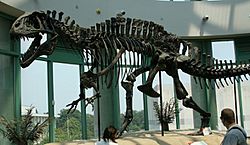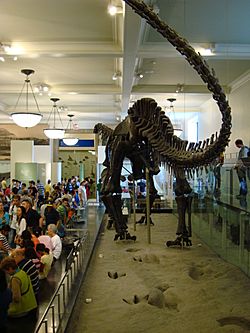Acrocanthosaurus facts for kids
Quick facts for kids AcrocanthosaurusTemporal range: Lower Cretaceous
116 to 110 mya |
|
|---|---|
 |
|
| Mounted Acrocanthosaurus skeleton at the North Carolina Museum of Natural Sciences. | |
| Scientific classification | |
| Kingdom: | |
| Class: | |
| Superorder: | |
| Order: | |
| Suborder: | |
| Infraorder: | |
| Family: | |
| Genus: |
Acrocanthosaurus
|
Acrocanthosaurus was a giant meat-eating dinosaur, known as a theropod. It roamed North America during the Lower Cretaceous period, about 116 to 110 million years ago. Its name means "high-spined lizard." This refers to the tall spines on its backbones, which likely formed a sail or a hump on its back.
This dinosaur was one of the biggest predators in North America before the famous tyrannosaurs appeared. It was almost as large as Tyrannosaurus rex.
Contents
Discovering Acrocanthosaurus
What's in a Name?
The name Acrocanthosaurus tells us something special about this dinosaur. "Acro" means high, "cantho" means spine, and "saurus" means lizard. So, it's the "high-spined lizard." These tall spines on its backbones were a unique feature. Scientists think they might have supported a hump or a low sail, similar to what you might see on a modern-day bison.
Where Does it Fit In?
When Acrocanthosaurus was first discovered, scientists weren't sure exactly where it belonged in the dinosaur family tree. At first, some thought it was related to Spinosaurus because of its back spines. However, most paleontologists now agree that Acrocanthosaurus is a type of carnosaur. More specifically, it's part of a group called carcharodontosaurids. This group includes other large predators like Carcharodontosaurus.
A Giant Predator
How Big Was It?
Acrocanthosaurus was truly enormous. It could grow up to 39 feet (about 12 meters) long. That's longer than a school bus! It weighed around 6 or 7 short tons, which is like the weight of two large cars. This made it the biggest meat-eating dinosaur in North America before the later evolution of the tyrannosaurs.
Unique Features
- High Spines: The most striking feature was the tall spines on its backbones. These spines could be over a foot tall.
- Snout Ridges: Acrocanthosaurus had long, low ridges on the sides of its snout. These ridges ran from its nostrils all the way back to its eyes. This feature is common in other dinosaurs related to Acrocanthosaurus.
Dinosaur Footprints
The Paluxy River Trackway
There's a very famous set of dinosaur footprints in Paluxy, Texas. These tracks show what might be an Acrocanthosaurus chasing its prey. It looks like a large theropod was following a plant-eating dinosaur. While this idea is exciting and seems possible, it's hard to prove for sure. There could be other explanations for how the tracks were made. Still, it gives us a glimpse into the dramatic lives of these ancient creatures.
Acrocanthosaurus in Media
On Screen
Acrocanthosaurus has appeared in television shows. For example, it was featured in an episode of the documentary series Monsters Resurrected. In the show, it was shown as the top predator in early Cretaceous North America. The story showed a young Acrocanthosaurus being scared away from its meal by a group of smaller, but fierce, Deinonychus. This forced the young Acrocanthosaurus to hunt tougher prey, like the armored dinosaur Sauropelta.
Images for kids
-
Acrocanthosaurus carrying a Tenontosaurus carcass away from a pair of Deinonychus
See also
 In Spanish: Acrocanthosaurus atokensis para niños
In Spanish: Acrocanthosaurus atokensis para niños









